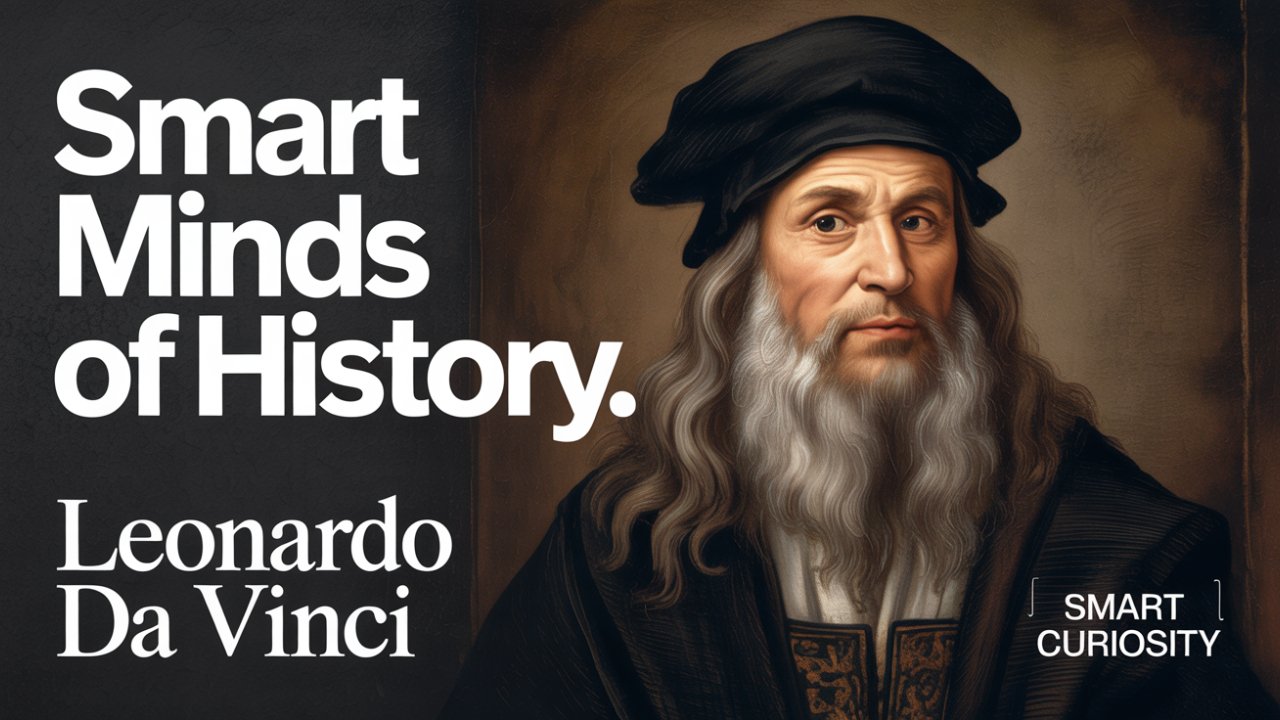What if one person could not only paint the world’s most famous smile but also design flying machines 400 years before the Wright brothers? What if that same person could map the human body’s inner workings, design terrifying war machines, and create some of the most beautiful religious art in history? This isn’t science fiction. This is the real-life story of a man whose genius was so immense that, five centuries later, we’re still trying to wrap our heads around it.
This is the story of Leonardo da Vinci, a name that’s become a synonym for genius. He wasn’t just an artist. He was an inventor, a scientist, a musician, an engineer, a botanist, and an anatomist. He was the original “Renaissance Man,” the living proof that the lines between different fields can dissolve in the face of relentless curiosity. His story isn’t just about incredible paintings or clever gadgets; it’s about the power of a mind that never stopped asking “Why?” and “How?” It’s about a life spent believing that everything in the universe was connected, just waiting to be understood.
Imagine a mind so curious it could dream up helicopters centuries before they existed, paint the most famous portrait in the world, and unlock the secrets of human anatomy all in one lifetime. That was Leonardo da Vinci, the ultimate Renaissance genius whose ideas still feel futuristic today. His life is a reminder that creativity and curiosity have no limits. He was a man who saw the future and, in many ways, helped build it. So, join us as we explore the life of this extraordinary mind, a mind that changed the world forever.
The Making of a Genius – Vinci, Florence, and the Workshop of a Master
Our story begins, not in a palace, but in the rolling hills of Tuscany. On April 15, 1452, in the small town of Vinci, Leonardo di ser Piero da Vinci was born. His name just means “Leonardo, son of Piero, from Vinci.” He was the illegitimate son of a respected legal professional, Ser Piero, and a young peasant woman named Caterina. In the rigid society of 15th-century Italy, this should have been a major disadvantage, shutting him out of prestigious careers. But for Leonardo, it might have been a secret blessing. With no pressure to follow in his father’s footsteps, he was free to follow his own curiosity wherever it led.
He grew up on his father’s family estate, where he received a basic education. But from a young age, his true classroom was the world around him. He was completely captivated by nature. He’d wander the Tuscan countryside, sketching the swirl of water in a stream, the delicate petals of a flower, or the way a bird caught the wind. His earliest dated work, from 1473, is a pen-and-ink drawing of the Arno valley. It’s not just a pretty picture; it’s a scientific investigation of geology and atmosphere, all rendered with an artist’s touch.
Recognizing his son’s incredible talent, Ser Piero made a life-changing decision. Around age 14, Leonardo was sent to Florence, the buzzing heart of the Italian Renaissance. He became an apprentice in one of the city’s top workshops: the studio of Andrea del Verrocchio.
Verrocchio was a master of all trades a painter, sculptor, and goldsmith. His studio was a creative whirlwind where art and engineering were one and the same. For a kid like Leonardo, it was the perfect playground. An apprenticeship here was hands-on. You weren’t sitting around talking theory; you were getting your hands dirty, grinding pigments, preparing wood panels, and learning the chemistry of art from the ground up.
Leonardo soaked it all in. He mastered drawing, painting, and sculpture, and also the technical arts that supported them. Verrocchio’s workshop was a collaborative hub, and he often relied on his best students to help with big commissions.
And here, the legend of Leonardo begins. The story goes that Verrocchio was working on a painting, “The Baptism of Christ,” and he tasked his young apprentice with painting one of the angels. According to the 16th-century biographer Giorgio Vasari, when Verrocchio saw the angel Leonardo had painted so lifelike and graceful that it made his own work look clumsy he was so humbled that he vowed never to paint again. The story is probably exaggerated, but the point is clear: even as a teenager, Leonardo’s skill was on another level. That angel, with its soft features and soulful eyes, was a preview of the revolutionary artist he would become.
By 1472, at age 20, Leonardo qualified as a master in the artists’ guild. He could have started his own studio, but he chose to stay with Verrocchio for a few more years. This period wasn’t all smooth sailing, though. In 1476, Leonardo and several other young men were anonymously accused of sodomy. The charges were eventually dismissed, but the public accusation and brief time in prison must have been a deeply unsettling experience.
After leaving Verrocchio’s workshop for good, Leonardo started taking his own commissions. He began work on a massive, complex painting, “The Adoration of the Magi,” for a local monastery. The unfinished painting is a storm of human emotion and dynamic movement, showing a mind so full of ideas it could barely be contained on a panel. But Florence was starting to feel too small for his ambitions. His mind was already wandering far beyond the canvas. He was filling notebooks with sketches of machines and studies of water. He saw himself as more than a painter. He was an engineer, an inventor. To find the support for his grand ambitions, he had to look elsewhere. His gaze turned north, to the powerful and wealthy city of Milan.
The Court of Milan – The Engineer of War and the Master of Souls
In 1482, around the age of 30, Leonardo made a huge career change. He left Florence, abandoning “The Adoration of the Magi,” and moved to Milan to work for the city’s powerful ruler, Ludovico Sforza. And this move wasn’t just about art. Milan was a military powerhouse, and Leonardo presented himself not as a painter, but as a cutting-edge military engineer.
In an amazing letter of introduction he sent to Sforza, Leonardo laid out his skills. He barely mentioned painting. Instead, he listed all the ways he could help win a war. He boasted he could design portable bridges, drain moats, and build terrifying siege engines. He described cannons that could hurl a storm of projectiles and armored vehicles a forerunner to the modern tank that could smash through enemy lines. Only at the very end of his ten-point resume of destruction did he add, almost as an afterthought, that in peacetime he could also be an architect and painter, “as well as any other.”
Ludovico Sforza was sold. He hired Leonardo, and for the next 17 years, the Milanese court became the perfect place for his many talents to shine. Ludovico loved spectacle and innovation, both on the battlefield and at parties. He kept Leonardo busy with a wild array of projects. One day, Leonardo would be designing the city’s canals; the next, he’d be orchestrating massive festivals with clever stage machinery and special effects.
During this time, Leonardo’s notebooks began to overflow. They were his private labs on paper, where he explored his relentless curiosity. He filled thousands of pages with drawings and notes, written in his famous right-to-left mirror script. He sketched designs for flying machines, studying birds to understand aerodynamics. He drew gears, pumps, and even a primitive submarine. He was obsessed with how the world worked, seeing nature as one giant, interconnected machine.
And, of course, he made art. Ludovico commissioned a giant bronze horse statue to honor his father, Francesco Sforza. The project was a massive engineering puzzle. Leonardo spent years studying horse anatomy and figuring out how to cast the 23-foot-tall statue in a single piece. He created a colossal clay model that awed the public, but the project was doomed. War with France was looming, and the bronze set aside for the statue was melted down to make cannons. The clay model was later used for target practice by invading French archers and destroyed a tragic end for one of Leonardo’s most ambitious projects.
But in the midst of all this, Leonardo created two of his greatest masterpieces. The first was the “Virgin of the Rocks,” where he perfected his sfumato technique creating soft, hazy transitions between colors that make the figures look like they’re emerging from mist. The second, and arguably the most famous religious painting ever, was “The Last Supper.”
Commissioned around 1495 for the dining hall wall of a convent, this work redefined storytelling in art. Leonardo chose the most dramatic moment possible: the instant after Jesus says that one of his apostles will betray him. What Leonardo captured wasn’t a static, posed scene, but a tidal wave of human emotion. Each apostle reacts differently with shock, anger, fear, or sadness. They’re arranged in dynamic groups, with all the emotion rippling out from the calm, central figure of Christ. To get this realism, Leonardo reportedly wandered the streets of Milan, sketching faces in the market to find the perfect expressions for the “motions of the soul.”
But his desire to innovate led to a fatal technical flaw. Instead of using the durable fresco method of painting on wet plaster, Leonardo experimented. He wanted the detail of oil paint, so he painted on a dry wall. This let him work slowly and create incredible detail, but it was a disaster for preservation. The paint never properly bonded with the wall, and just a few years after it was finished, the masterpiece began to flake away.
Even in its fragile state, “The Last Supper” was an instant classic. Its emotional power and realism set a new standard for art. For seventeen years, Leonardo had poured his genius into Milan. But the good times were ending. In 1499, French forces invaded, and Ludovico Sforza was overthrown. Leonardo’s patron was captured and would die in a French prison. Once again, Leonardo was an artist without a job. He packed up his notebooks and fled Milan, looking for his next chapter.
The Florentine Rival – A Stolen Smile and a Battle of Giants
After leaving Milan, Leonardo wandered for a bit before returning to Florence in 1500. But the city had changed. A new artistic star was on the rise, a younger, more intense talent who was taking the art world by storm. His name was Michelangelo.
A rivalry was inevitable. They were the two titans of the Renaissance, but their personalities couldn’t have been more different. Leonardo, now in his late 40s, was charming, elegant, and saw painting as a science. Michelangelo, 23 years younger, was moody, scruffy, and a sculptor at heart, believing that carving the human form from stone was the highest art. They didn’t hide their dislike for each other. Michelangelo openly mocked Leonardo for failing to cast his giant horse statue. Leonardo shot back in his notebooks, writing dismissively of sculptors who made their figures look like “a bag of walnuts” a clear dig at Michelangelo’s muscular style.
This rivalry was about to go public. In 1503, the city of Florence commissioned both men to paint huge battle murals on opposite walls of the Great Council Hall. It was a head-to-head competition, a clash of the giants. Leonardo was assigned “The Battle of Anghiari,” a chaotic and brutal scene of cavalry combat. Michelangelo’s was “The Battle of Cascina,” showing soldiers surprised by an attack while bathing.
All of Florence was buzzing, ready for the ultimate artistic showdown. But in the end, the “Battle of the Titans” never happened. Both projects fizzled out. Michelangelo was called to Rome by the Pope. Leonardo, always experimenting, tried a new painting method that failed spectacularly, causing the colors to run. He abandoned the project in frustration. Like the great horse, another of his grand ambitions was left unfinished.
But during this same time, Leonardo started a much smaller, more personal painting. It was a portrait of Lisa Gherardini, the wife of a silk merchant named Francesco del Giocondo. It was a painting he would never deliver. Instead, he kept it with him for the rest of his life, carrying it across the Alps to France, constantly adding thin, shimmering layers of paint. The world would come to know it as the “Mona Lisa.”
At first glance, it looks like a simple portrait. But Leonardo poured a lifetime of scientific and artistic knowledge into it. He broke tradition by having Lisa turn towards the viewer, creating a direct connection. Her hands are perfectly relaxed, an anatomical study in themselves. The landscape behind her is strange and dreamlike. And he masterfully used aerial perspective, making the distant mountains hazy and blue to create an incredible sense of depth.
But of course, it’s the face that gets you. Leonardo used his sfumato technique to perfection. There are no hard lines. The corners of the eyes and mouth are blurred into soft shadows, creating a mysterious ambiguity. Is she smiling? Is she sad? Her expression seems to change as you look at her. Leonardo achieved this by understanding both human anatomy and how our eyes perceive light. By blurring the details, he makes our own minds complete the image, creating a psychological connection that’s endlessly fascinating.
The “Mona Lisa” is more than a portrait; it’s a summary of everything Leonardo knew. It’s the perfect marriage of art and science, a window into the soul of both the subject and the artist. While his huge public projects in Florence ended in failure, this small, private obsession would become his most famous legacy.
The Wandering Observer – The Secrets of the Human Machine
While art was his public-facing job, a private obsession drove Leonardo his whole life: understanding the human body. This wasn’t just to make his paintings better. It was a deep, scientific quest to figure out the mechanics of life itself, to take apart the “human machine” and see how it worked.
To Leonardo the artist, anatomy was key. He wanted to know how muscles formed a smile or how bones moved to create a gesture. But Leonardo the scientist wanted to go deeper. How does the eye see? How does the heart pump blood? How does a baby develop in the womb? To find the answers, he did something highly controversial and often illegal for anyone but a doctor: he dissected human corpses.
Working by candlelight, often in secret, he is said to have dissected numerous bodies of men, women, and children. The exact number is debated by historians, with some estimating it could be as high as 30. This was foul, difficult work, but the drawings that came from it are breathtaking. They are masterpieces of both scientific accuracy and artistic beauty. He was the first to draw the human spine with its correct curve. His drawings of muscles and tendons are so precise they could be used in a medical textbook today. He would draw a limb from multiple angles, peeling back the layers of muscle, creating a kind of 4D view on a 2D page.
He didn’t stop at muscles and bones. To understand the heart, he injected its chambers with molten wax to make a perfect cast of their shape. He then built a glass model of the aorta and pumped water with seeds through it to study blood flow, discovering the swirling vortex that helps close the aortic valve. His work was revolutionary, even if he didn’t map out the full circulatory system we know today. He was the first to describe arteriosclerosis the hardening of the arteries and cirrhosis of the liver.
He even made the first known wax cast of the ventricles of the brain, trying to locate the physical source of thought and senses. The engineer in him saw the body as a perfect machine. The artist captured its beauty. The philosopher in him grappled with the meaning of life and death.
He planned to compile all this research into a massive, illustrated book on anatomy. Had he published it, the history of medicine could have been very different. But, like so many of his projects, it was never finished. The sheer scale of the work and his own perfectionism meant it remained a scattered collection of notes and drawings in his private journals. For centuries, these incredible discoveries remained hidden from the world, a secret testament to a mind that wanted to understand everything, starting with ourselves.
A Home in France – The Twilight of a Genius
After another period in Milan and a frustrating time in Rome, where he felt overshadowed by younger rivals like Raphael and Michelangelo, Leonardo, now in his 60s, got an invitation he couldn’t refuse. In 1516, the young King of France, Francis I, a huge fan of the Italian Renaissance, invited Leonardo to join his court. He gave Leonardo the grand title of “First Painter, Engineer, and Architect to the King.”
Leonardo packed up his notebooks and his favorite paintings including the “Mona Lisa” and crossed the Alps. King Francis I didn’t give him deadlines; he gave him a generous salary and a beautiful manor house, the Château de Cloux, near the king’s own palace. For the first time, Leonardo was honored not for what he could do, but simply for who he was. The king, they said, just loved to listen to him talk.
Though a stroke had likely paralyzed his right hand, making it hard for him to paint, Leonardo’s mind was as sharp as ever. He spent his final years organizing his thousands of pages of notes. He still took on a few projects for the king, like designing court festivals. One of his last known inventions was a mechanical lion that could walk forward and open its chest to reveal a spray of lilies, the symbol of France. He also designed an ideal city, Romorantin, with advanced ideas about canals and multi-level streets. The city was never built, but some of its concepts, like a double-helix staircase, are thought to have influenced the design of the magnificent Château de Chambord.
The bond between the old master and the young king was real. A famous legend, often depicted in paintings, says that Leonardo died in the arms of the king. It’s a lovely image, but historical records suggest Francis I was probably away on that day. Still, the story shows just how deeply he was respected.
Leonardo da Vinci died on May 2, 1519, at the age of 67. In his will, he left his drawings, instruments, and priceless notebooks to his most loyal student, Francesco Melzi. The “Mona Lisa,” which he’d tinkered with until the end, passed into his assistant’s possession. It was eventually acquired by King Francis I, which is why it hangs in the Louvre Museum in Paris today, though the exact chain of ownership is still debated by historians.
Melzi spent the next 50 years trying to organize Leonardo’s scattered papers, but the task was just too big. After Melzi died, the collection was tragically broken up and scattered across Europe. It wasn’t until centuries later, as the notebooks were rediscovered, that the world began to understand the true, staggering scope of Leonardo’s genius.
Leonardo’s story is an incredible reminder of what a curious mind can achieve. If you’ve been captivated by this journey, please subscribe to Smart Minds of History for more stories about the people who shaped our world. Don’t forget to like this video, and let us know in the comments: what part of Leonardo’s work amazes you the most? The artist, the
The Enduring Legacy – The Man Who Saw the World Anew
So how do you measure the legacy of someone like Leonardo da Vinci? It’s not just in his handful of paintings, though they’re among the most famous in history. It’s not just in his notebooks, though they contain ideas centuries ahead of their time. Leonardo’s true legacy is in how he saw the world. He taught us to look closer, to question everything, and to see the beautiful connections that tie the universe together.
In art, his impact was immediate. He turned painting from a craft into a science. His techniques gave art a new psychological depth. Masterpieces like the “Mona Lisa” and “The Last Supper” don’t just tell a story; they explore the inner lives of their subjects what he called the “motions of the soul.”
In science, his legacy is more complicated. Because his notebooks weren’t published, he didn’t directly influence the scientific revolution like Galileo or Newton did. He was a prophet whose prophecies were kept private. Yet, looking at his work now, we see a modern mind at work. His anatomical drawings were astonishingly accurate. His designs for gears and machines anticipated the industrial age. And his obsession with flight was one of the boldest imaginative leaps in history.
But perhaps his most important legacy, especially today, is his example of interdisciplinary thinking. In a world that pushes us to specialize, Leonardo’s life proves the power of connecting different fields. He refused to see a wall between art and science. To him, they were just two different languages for describing the same, amazing reality. The swirl of water in a river was connected to the flow of blood in an artery. The wing of a bird held the secrets to human flight.
His entire life was driven by a relentless, joyful curiosity. His personal motto was Saper Vedere “To know how to see.” He showed us that the world is a web of infinite and beautiful complexity, and that by observing it with passion and precision, we can start to understand our place in it. Five hundred years later, Leonardo still inspires us, a timeless symbol of what the human mind is capable of when it refuses to stop learning, questioning, and dreaming.





